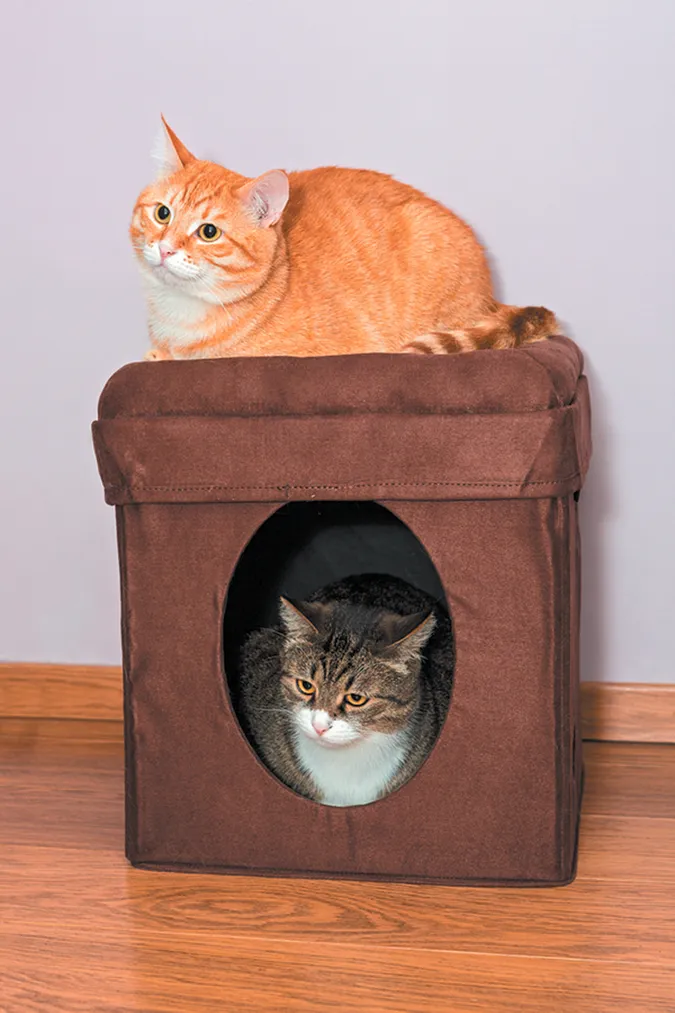Cats are by nature territorial animals. They work hard in the wild to carve out their own space because, as solitary predators, they rely on their own abilities to catch prey rather than acting in groups. They also try to avoid chance encounters with other cats in order to sidestep fighting and injury. What that means is that even if two cats claim the same territory and forage in the same general vicinity, they don’t forage at the same time.
House cats are territorial in the same way. That can be hard to understand for people with more than one cat, since their cats may spend a lot of time hanging around in the same vacinity.
But house cats establish territories just like their feral brethren — through time sharing. If you have two or three cats, note where each one perches during the day. Over a few days, you’re likely to see a distinct pattern emerge. One cat may sit on a particular window sill from 10 in the morning till noon. Another cat may enjoy sitting at the very same spot, but never before 2 pm. They’ve got it worked out perfectly.
A study of domestic cats found that it’s often felines of the same gender that engage in time sharing. A notable exception: mothers who time share with their male kittens.
When territory sharing goes awry
Of course, things are not always hunky-dory. Cats who have always gotten along perfectly (or at least reasonably) well may start having territorial disharmony. Or a new cat comes to live with you and the cat who has been there a while is not interested in sharing his favorite places or his resources. Signs of territoriality might be relatively subtle and include urine marking (spraying) on the walls or other parts of the house, voiding outside the litter box, and tail swishing when the other cat walks by. But they can progress to more obvious indications of territorial aggression, including attacking the other cat with claws and teeth. Sometimes a cat will direct his territoriality not at the cat he perceives as an interloper but at you — hissing, swatting at you, or worse.
What to do — and what not to do
If your cat has become territorially aggressive, you should take him to the doctor for a medical work-up. This is particularly true for a cat who has lived with another cat for some time but begins giving the other cat a hard time seemingly out of the blue. Sometimes territorial aggression can be a sign of pain, a thyroid abnormality, a neurological disorder, or another medical condition. If that’s the case, treating the disease should take care of the behavioral problem.
But whether the source of the problem is medical or behavioral, there are steps you can take right away to get ahead of the situation.
Don’t let the two cats fight it out. Sometimes dogs are able to work things out on their own, but with cats, the more they fight, the worse things tend to get. The fighting just serves to reinforce the antagonism. Blow on a loud whistle to distract them or bang on a metal pot. You can squirt water on the aggressor, too. Do not try to physically get in there to break it up or pick up an agitated cat to remove it. You could end up becoming collateral damage.
Keep the two cats separate. Keep cats in separate rooms with the door closed when there’s an issue of territoriality between them. Each day, switch them to each other’s rooms so they can adjust to the other’s scent in a quiet manner. After a few days, if both cats appear relaxed, crack open the door a tiny bit. If they remain calm, crack it open a little more. If you see any signs of aggression — growling, spitting, hissing — go back a step and then gradually ramp up again.
Provide escape hatches. Make sure there are always routes for your cats to be able to get away from each other. They need to know they don’t have to be stuck together.
Provide distractions. Give your cats lots of toys and spend time interacting with them. Distractions are never bad for easing tension.
Remain calm and keep the routine steady. Cats are extremely uncomfortable without predictability. Work hard to stay on schedule with feedings and play times and anything else that your cats perceive as part of the rhythm of the household. Unpredictability can keep a cat from adjusting, or readjusting, to sharing space with his feline housemate.
If necessary, seek professional help. When all else fails, a behaviorist can help you strategize about defusing the situation in your own cats’ particular circumstances. And a veterinarian who’s also a behaviorist might prescribe mood-stabilizing medications to help get a territorially aggressive cat over the hump. (See the article on page 6 for how to choose an animal behaviorist for your pet.)





I love all the advice that is given for everyday cat life in a human home. I learned a lot about sharing space in a one cat household. I love my feral turned house cat very much even after a long adjustment period. She is wonderful. I do not think she will enjoy sharing her domain. My hopes of taking in another cat have been put on hold. Great advice to ponder if I change my mind.